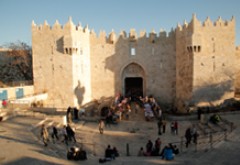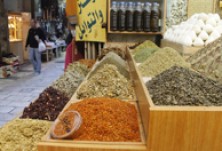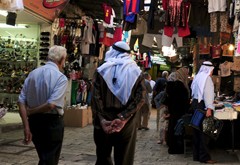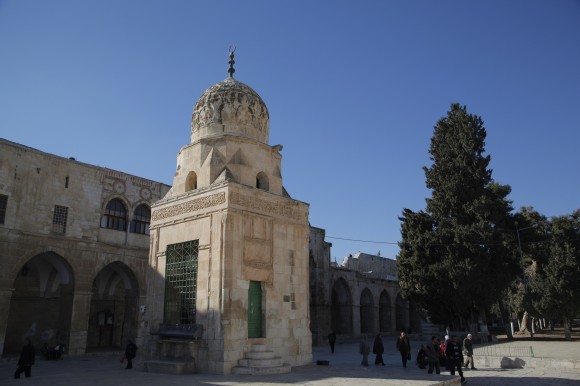Style and Grandness of the Sabil
In style and design, Qaytbay Sabil resembles Sabil Ibrahim Al-Rumi. However, it is grander and far more ornamented, as well as larger. Sabil Qaytbay is Jerusalem’s most famous Sabil and by far its most spectacular. It is among the most beautiful domed structures in al-Aqsa area, with its dome representing typical late Mamluk architecture in general, and Cairene architecture in particular.
Sabil Caretakers
This Sabil was initially built at the order of the Mamluk Sultan Saif al-Din Inal, and was rebuilt by the Sultan al-Ashraf Qaytbay in 1482 AD (887 H) as an annex to al-Madrassa al-Ashrafiyya across from it. The only part of the Sabil Inal remaining is the well on which Qaytbay built his Sabil. Later on, the Sabil was renovated upon the orders of the Ottoman Sultan ‘Abed al-Hamid II in 1882 - 3 AD / 1300 H, as the inscription shows. al-Aqsa Mosque Renovation Committee has recently renovated it.
Sabil Description
The Sabil entrance faces east, and the Sabil is entered through a round staircase resting on a stone mastaba. The structure stone courses were built with alternating red and yellow stones, known as ablaq in Arabic. A band of calligraphic inscriptions adorns the top of the structure, comprising Quranic verses inscribed in the Mamluk Naskhi calligraphy style. The top of the Sabil is distinguished by its high stone dome, covered with outstanding Arabesque ornaments. This dome is the only example of Mamluk Egyptian art outside Cairo. However, there is no similar Sabil of this style in Cairo, though there are mausoleums with similar style domes. Sabils in Cairo were normally a room in a complex, without a dome. In addition, Sabil Qaytbay dome is built from stone and is covered with Arabesque carvings and ornaments.
Egyptian Mamluk Influence
The architectural and ornamental building elements are basically influenced by the Egyptian building traditions. This is understandable because builders and artisans were Egyptians, who brought with them dome building and ornamenting styles which adorned Cairene domes, particularly in mausoleums and tombs. It is possible that those builders who built the Sabil are the same ones who built al-Madrasa al-Ashrafiyah before embarking on building the Sabil.
It is noteworthy that in 1982, a failed attempt was made to penetrate al-Aqsa Mosque grounds as part of the Tunnel excavations led by Yehuda Me’ir Gates, the Westren Wall rabbi, from under the Sabil Qaytbay’s well, where an Umayyad Bab (gate) used to connect to al-Aqsa Mosque. The gate was named after Charles Warren, the British explorer of Jerusalem who discovered it.








